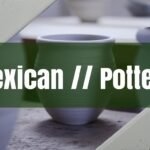Talavera pottery, with its vibrant colors and intricate designs, is a treasured art form deeply rooted in the cultural heritage of Puebla, Mexico. Creating authentic Talavera is a meticulous process that demands skill, patience, and a dedication to time-honored techniques. This article provides a comprehensive guide to understanding and creating authentic Talavera pottery, from the selection of materials to the final firing, while respecting the tradition and standards that define this unique art.
The Clay
The journey of Talavera pottery begins with the careful selection and preparation of clay. Authentic Talavera utilizes a blend of two distinct clay types: a dark or black clay and a white clay, combined in equal parts. The specific sources for these clays are often local to the Puebla region, with some potters sourcing black sands from Amozoc and white sands from Tecali. The preparation process is crucial for ensuring the clay’s workability and the final product’s quality. Initially, the raw clay undergoes a thorough cleaning, often involving sieving to remove impurities. The clay is then mixed with water and placed in sedimentation tubs, allowing excess water to evaporate. This “maturation” period enhances the clay’s plasticity, making it easier to shape. The next step involves kneading the clay to achieve a uniform consistency and humidity. Traditionally, this was done by “stepping on” the clay, where artisans would walk over it to compress and homogenize the material. Today, mechanical pugmills are also used to achieve the same result. Once prepared, the clay is formed into blocks and stored, ready for shaping into the desired pottery forms. This foundational process of clay preparation is vital for the subsequent stages of Talavera production, influencing the pottery’s durability, texture, and overall aesthetic appeal. More on the process of production.
The Shaping
The shaping of Talavera pottery is where the artisan’s skill truly shines. The prepared clay can be shaped using a variety of techniques, including the potter’s wheel and molds. On the potter’s wheel, skilled artisans create symmetrical forms, such as bowls, plates, and vases, using their hands to coax the clay into the desired shape. For more complex or repetitive forms, molds are employed. The clay, with a consistency similar to flexible dough, is pressed into the molds, carefully shaping the piece. Once the initial shaping is complete, the pottery is left to air dry. This drying process is critical, as it allows the clay to gradually lose moisture, reducing the risk of cracking during firing. Read more about rediscovering Talavera pottery.
After the pieces are thoroughly dried, they undergo their first firing, known as the bisque firing. This firing transforms the raw clay into a hardened state, making it easier to handle and decorate. The bisque firing typically occurs at temperatures around 900 degrees Celsius (1650 degrees Fahrenheit), resulting in a porous, orange-colored ceramic known as “jahuete” or “sancocho”. Following the bisque firing, the pieces are carefully inspected for imperfections. Artisans meticulously sand the surface to remove any roughness or irregularities. They also use sound to detect variations in thickness, cracks, or bubbles that could compromise the pottery’s strength. This attention to detail ensures that only the highest quality pieces proceed to the next stage of decoration and glazing. Read more about the Talavera pottery process.
Glazing and Painting Talavera Pottery
The glazing and painting of Talavera pottery are what give it its distinctive character and vibrant beauty. The glaze used in Talavera is traditionally a mixture of silica sand, tin, and lead, resulting in a viscous, vanilla-colored coating. This enamel provides a smooth, opaque surface for the painted designs, enhancing their brilliance and durability. More information about the glazing and painting process.
Before painting, the bisque-fired pottery is dipped into the glaze, ensuring an even coating. Once the glaze has dried, the artisans begin the intricate process of hand-painting the designs. Traditional Talavera pottery designs often feature a blend of Old World and indigenous motifs. Polychrome designs and blue-and-white patterns reflect the pottery’s Spanish heritage, while native floral and animal motifs celebrate its Mexican identity. View traditional pottery designs. The colors used in Talavera pottery are derived from natural mineral pigments. Artisans use fine mule hair brushes to apply the colors with precision and skill. The painting process requires a steady hand and a deep understanding of the traditional designs and their symbolic meanings. The completed, hand-painted designs bring the Talavera pieces to life, infusing them with cultural significance and artistic flair. After the painting is complete, the pottery undergoes a second and final firing. This firing fuses the glaze and the painted designs to the ceramic body, creating a durable and vibrant finish. The high temperatures of the firing, typically around 1050 degrees Celsius (1920 degrees Fahrenheit), ensure that the colors are permanently set and the glaze is vitrified, resulting in a glossy, crack-resistant surface. Firing Temperatures: A Potter’s Guide. How to treat Authentic Talavera Pottery.
Standards, Care, and Modern Adaptations
Authentic Talavera pottery is distinguished by its adherence to strict standards and certifications. The Denomination of Origin (D.O.) status, obtained in 1997, limits the production of authentic Talavera to specific regions in Mexico, including Puebla, Cholula, Tecali, and Atlixco. This designation ensures that only pottery produced within these areas, following traditional methods, can be called “Talavera”. The Consejo Regulador de la Talavera (Talavera Regulatory Council) oversees the production and certification process. Workshops must undergo inspections every six months to ensure they meet the required standards. Certified Talavera pieces bear the signature of the potter, the logo of the workshop, and a special hologram, guaranteeing their authenticity. Pottery: A Cultural Identity Preserved. Learn more about the history and importance of Talavera pottery.
Maintaining the beauty and longevity of Talavera pottery requires proper care. Due to its handcrafted nature and delicate paintwork, Talavera should be handled with care. It is best to handwash Talavera pieces using gentle, non-abrasive cleaning materials. While Talavera is fired at high temperatures, making it durable, avoiding harsh chemicals and abrasive scrubbers is essential to protect the intricate designs. A guide to caring for your pottery. For outdoor use, Talavera planters should be elevated to ensure proper drainage and prevent moisture absorption. In freezing climates, it is advisable to move Talavera pieces indoors or cover them to protect them from rapid temperature changes. With proper care, Talavera pottery can last for years, preserving its beauty and cultural significance.
While rooted in tradition, Talavera pottery has also seen modern adaptations and contemporary uses. Artists are collaborating with Talavera workshops to create innovative designs that blend traditional techniques with modern aesthetics. These collaborations have resulted in unique pieces that reflect both the heritage of Talavera and the creative vision of contemporary artists. Learn about Uriarte contemporary Talavera. Talavera tile is also experiencing a resurgence in popularity, used in kitchens, bathrooms, and outdoor spaces to add a touch of Mexican flair. From sinks and backsplashes to stair risers and patios, Talavera tile brings vibrant color and intricate patterns to a variety of architectural applications. View Talavera tile designs.
Modern applications of Talavera also incorporate eco-friendly materials and digital design tools, reflecting a commitment to sustainability and innovation. Despite these modern adaptations, the essence of Talavera pottery remains rooted in its traditional techniques and cultural heritage. The ongoing evolution of Talavera ensures that this art form remains relevant and vibrant for generations to come. Read about Mexican Pottery in the modern day.





